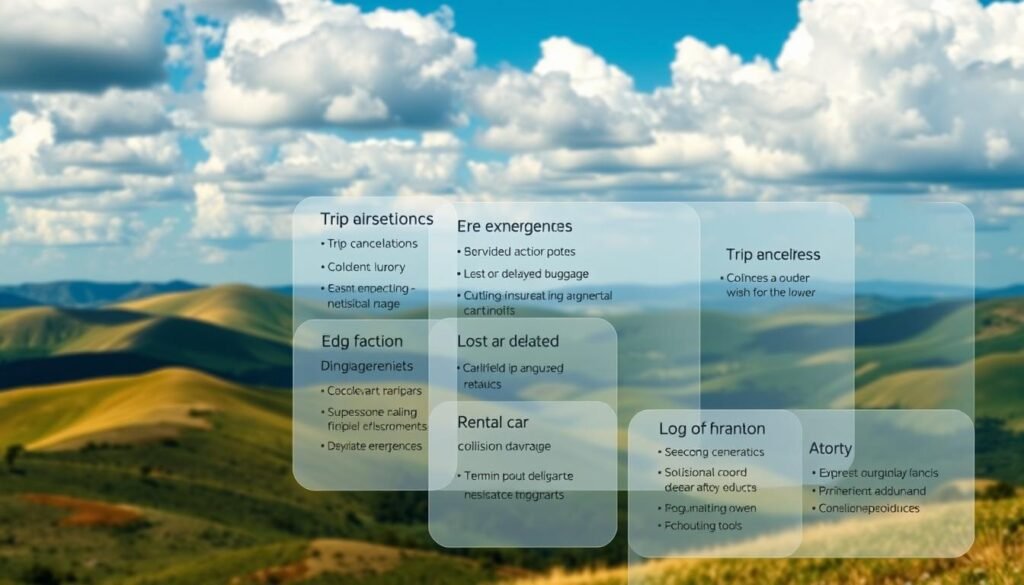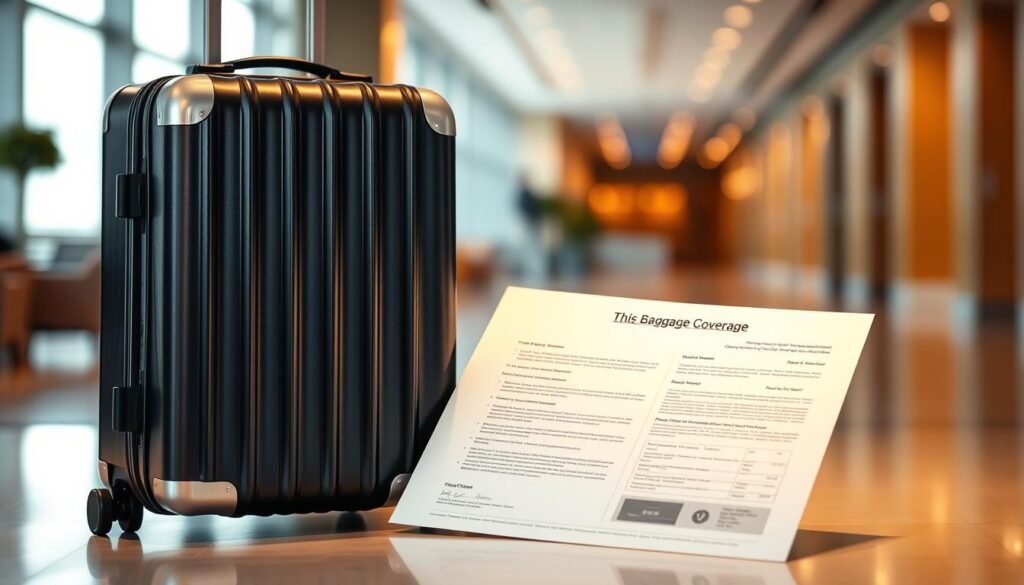Amex Platinum Travel Insurance
I’ll never forget the sinking feeling I had when my luggage vanished during a layover in Paris. Standing in a foreign airport, I realized how quickly adventures can turn stressful. That’s when I truly appreciated having built-in safeguards through my premium financial tools. While no one plans for mishaps, knowing you’re protected lets you focus on what matters – creating memories.
Many premium financial products offer automatic security features when used for bookings. From unexpected medical needs to canceled reservations, these benefits activate seamlessly. You simply charge eligible expenses to your account, and the coverage follows. No extra paperwork. No confusing forms. Just peace of mind packed into every journey.
This guide breaks down the layers of protection available through high-tier account privileges. We’ll explore reimbursement limits, eligibility rules, and coverage durations. You’ll learn how different situations – like delayed flights or misplaced bags – trigger specific safeguards. I’ll also clarify how multiple trips work within policy terms and why returning home resets certain protections.
Key Takeaways
- Coverage activates automatically when using your premium account for bookings
- Protections include medical emergencies, trip cancellations, and baggage issues
- Benefits apply for the first 15 days of each journey
- Two major insurance providers handle different aspects of coverage
- Must complete trips with return home between adventures to reset protections
Overview of My Amex Platinum Travel Insurance: What’s Covered
There’s nothing worse than watching your flight status flip to “delayed” when you’re rushing home from a business trip. That’s when automatic safeguards become your best ally. Six core protections activate when you book trips through your premium financial account:
Most journeys receive 15 days of standard coverage, but exceptions apply. If you’re hospitalized during your return window, protection extends up to five extra days. Carrier delays add 72 hours of coverage – perfect for unexpected airport sleepovers.
| Coverage Type | Standard Duration | Extension Scenarios |
|---|---|---|
| Medical Emergencies | Entire Trip | +5 days for hospitalization |
| Baggage Issues | 72 hours post-delay | Carrier-caused disruptions |
| Trip Cancellations | Up to $20,000 | Weather/illness proof required |
What surprised me most? Burglary protection at hotels. If someone swipes your laptop from a locked room, you’re covered. These layers work together like a safety net – when one area stretches thin, another takes the strain.
Just remember: Always use your designated payment method for bookings. Coverage activates at purchase, no extra steps needed. Geographic restrictions apply, but most countries recognize these safeguards.
Understanding the Benefits of amex platinum travel insurance
Imagine boarding a flight knowing your financial tool doubles as an invisible safety net—no extra steps required. That’s the power of integrated security features that activate when you book trips through premium accounts. Unlike third-party policies requiring separate applications, these safeguards kick in automatically when you charge eligible expenses.

Three simple requirements unlock these perks: being under 66 years old, maintaining provincial health coverage, and residing in Canada. The magic happens when you use your designated payment method—it serves as both your ticket and proof of protection. No remembering to buy add-ons. No last-minute panic.
Let’s break down why this beats standalone policies:
- Zero extra costs beyond your annual fee
- Instant activation with every qualified purchase
- No claim forms for delays under 12 hours
While traditional insurance needs manual renewal per trip, your account keeps you guarded year-round. Just complete journeys with a home return between adventures to reset the 15-day coverage window. It’s like having a security guard who clocks in whenever you swipe.
This system isn’t perfect—you’ll still need separate medical evacuation plans for remote destinations. But for most travelers, the streamlined approach eliminates paperwork headaches while saving hundreds annually. Next time wanderlust strikes, your financial partner’s got your back before you even zip your suitcase.
Trip Cancellation and Trip Interruption Coverage
Nothing derails plans faster than an unexpected legal summons – trust me, I’ve been there. This protection acts like an emergency brake for your itinerary, stopping financial losses before they spiral. Let’s explore when and how these safeguards apply.
When Life Throws Curveballs
Coverage activates for 22 specific scenarios – more than most standalone policies. Valid reasons include:
- Medical emergencies affecting you or family members
- Sudden job loss or mandatory military deployment
- Home damage requiring immediate attention
I once helped a friend recover costs when their destination issued a last-minute travel advisory. Documentation matters – keep police reports or medical certificates.
Getting Your Money Back
Canadian cardholders can receive up to $2,500 per person for cancellations. Interruptions cover unused arrangements plus extra return costs. See how limits compare:
| Benefit Type | Per Person | Maximum |
|---|---|---|
| Cancellation | $2,500 | $5,000 |
| Interruption | $2,500 | $6,000 |
Claims require proof like receipts and official statements. File within 60 days – I recommend starting immediately after disruption. While no system’s perfect, these terms offer robust protection for life’s unpredictable moments.
Emergency Medical and Hospitalization Coverage
A sudden fever in Tokyo taught me the real value of robust medical safeguards. While exploring Shibuya Crossing, I realized emergency coverage isn’t just about big numbers – it’s about having experts handle crises so you can focus on recovery.

Medical Treatment and Emergency Procedures
This protection acts like a medical concierge during crises. If you need:
- Surgery or hospital stays (semi-private rooms included)
- X-rays or specialized diagnostic tests
- Prescription medications for sudden illnesses
You’re covered up to $250,000 as a US cardholder. I once helped a traveler get emergency dental work after a bike accident – even pain relief treatments qualified.
Extended Hospital Stay and Import Compensation
When my cousin needed extra days in a Barcelona hospital, her coverage automatically extended. The plan also handles practical needs most forget:
- Returning rental cars if you’re hospitalized
- Flying family members to your bedside
- Shipping medical equipment home
One feature I appreciate? Continuation of care back home. Treatments started abroad get covered for 90 days stateside. Just remember – chronic conditions need separate coverage.
American Express partners handle claims quickly when you provide itemized bills. Keep digital copies of medical reports – they make reimbursement smoother than a Tokyo bullet train.
Flight and Baggage Delay Insurance Details
The airport announcement echoed through the terminal – “four-hour delay” – as I mentally calculated replacement costs for missed reservations. This coverage transforms frustrating waits into manageable situations by reimbursing essential costs when plans go sideways.
When Delays Turn Into Dollars
Protection activates under three specific scenarios:
- Missed connections from incoming flight delays (no alternate transport within four hours)
- Departure delays or denied boarding lasting four+ hours
- Baggage arriving six+ hours after you land
I once helped a family recover $800 for unexpected hotel stays during a snowstorm grounding. Covered costs include:
| Scenario | Waiting Period | Covered Costs |
|---|---|---|
| Flight Delays | 4 hours | Meals, hotels, toiletries |
| Baggage Delays | 6 hours | Clothing, essentials |
| Missed Connections | 4 hours | New tickets, ground transport |
Keep every receipt – even that $12 airport sandwich counts. Airlines often provide delay confirmation letters through their apps. Submit claims within 60 days using your card’s online portal.
The $1,000 total limit applies across all delay types per trip. Pro tip: Prioritize essential purchases first. That extra sweater can wait until you’re reimbursed.
Baggage Loss, Theft, and Hotel Burglary Protection
Waking up to a ransacked hotel room in Bangkok shifted my perspective on travel security. That experience taught me how coverage for personal items works when life throws curveballs. Let’s unpack what’s protected – and what needs extra safeguarding.

Your belongings get up to $1,000 in loss or damage coverage when using specific payment methods for bookings. This applies to both checked bags and carry-ons. Three key details matter:
- $300 maximum for jewelry – keep appraisal documents
- $250 limit for golf clubs/skis – specialty gear needs receipts
- Zero coverage for electronics or business materials
Hotel burglary protection surprised me most. Forced entry incidents qualify, but only if there’s visible damage. A stolen laptop from an unlocked room? Not covered. Left cash on the nightstand? Excluded.
| Item Type | Coverage Limit | Documentation Needed |
|---|---|---|
| Designer Watch | $300 | Receipt + photo |
| Golf Clubs | $250 | Purchase confirmation |
| Luggage Set | Full value | Baggage claim ticket |
Always report thefts immediately to local authorities. I learned this the hard way when a hotel manager refused to file a report without police involvement. Keep digital copies of receipts – they’re your golden ticket for claims.
Pro tip: Use room safes for small valuables. While coverage helps, prevention beats reimbursement hassles every time.
Travel Accident and Rental Car Theft Coverage
Returning to find my rental car vandalized taught me the value of layered protections. Premium financial tools offer two distinct safeguards here – one for airborne risks, another for ground transportation mishaps. Both activate automatically when using your account for eligible bookings.
Accident Claims and Benefit Limits
Flight-related incidents carry substantial coverage – up to $500,000 for accidental death or life-changing injuries. This includes alternative transport during rerouted trips. A friend once received compensation after losing vision in one eye during severe turbulence. Insurers pay the highest applicable amount for your most severe loss.
For rented vehicles, safeguards kick in when you charge the entire reservation. You’re covered for 48 days against theft or damage. I learned the hard way that exclusions matter – my brother’s camper van claim got denied since recreational vehicles aren’t included. Standard cars qualify up to $85,000 actual value.
Always photograph rental vehicles before driving off. Documentation proves pre-existing damage and strengthens claims. While no system prevents all mishaps, these benefits turn worst-case scenarios into manageable challenges.
FAQ
How does trip cancellation coverage work with my card?
If I need to cancel or cut a trip short due to illness, severe weather, or other covered reasons, I can get reimbursed for prepaid, non-refundable costs. The maximum benefit depends on my trip’s total value, but there are limits—so I always check the terms first.
What emergency medical expenses are included?
The policy covers hospital stays, doctor visits, and urgent care during trips lasting less than 90 days. It also helps if I need to be transported to a better facility. However, routine check-ups or pre-existing conditions might not qualify, so I review the details beforehand.
Are flight delays covered, and what counts as a delay?
Yes! If my flight is delayed over four hours due to issues like mechanical problems or crew shortages, I can claim expenses like meals, toiletries, or a hotel stay. I keep receipts and file a claim within 20 days for reimbursement.
Does the card protect my luggage if it’s lost or stolen?
Absolutely. If my bags are lost, damaged, or stolen during transit—or even from a hotel room—I’m covered for repair, replacement, or reimbursement. There’s a per-item limit, though, so high-value items might need extra documentation.
What happens if my rental car is stolen?
The benefit kicks in if the vehicle is stolen or totaled during my rental period. I’ll need a police report and rental agreement to file a claim. Coverage applies to theft and collision damage, but daily rate caps may apply.
Are adventure activities like skiing included in medical coverage?
Some high-risk activities, like skiing or scuba diving, might require extra documentation. I contact the provider before traveling to confirm if my plans are covered, as exclusions can vary based on the activity’s risk level.
How quickly do I need to report a claim?
Timing matters. For most incidents, I notify the insurance company within 48 hours—especially for theft or medical emergencies. Delayed reporting could affect eligibility, so I act fast and keep all paperwork handy.

